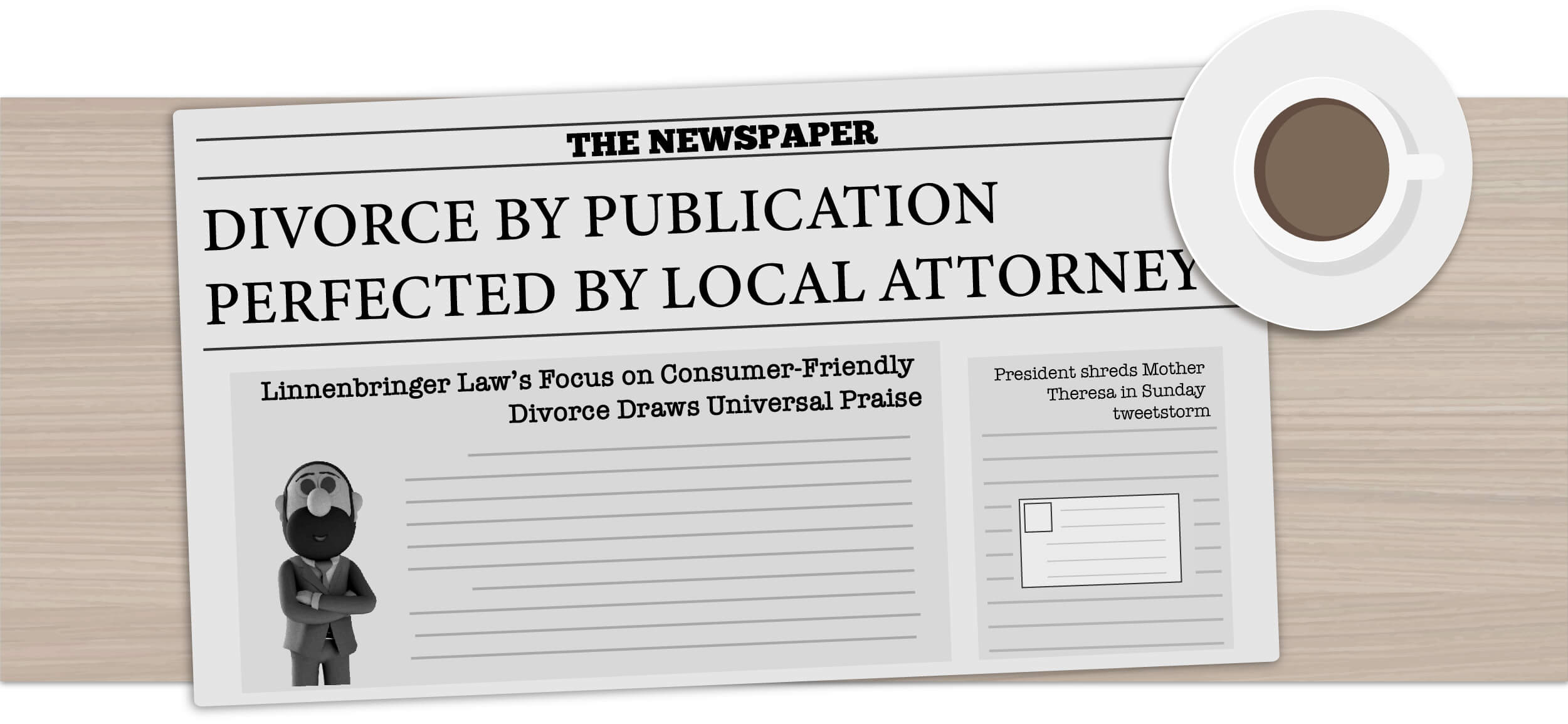Every lawsuit - and a divorce is technically a lawsuit - starts with the Respondent (the non-filing party) either being served or waiving service (with an uncontested divorce, the Respondent will generally waive personal service, so as to avoid the expense, hassle, and embarrassment of being served). Separations can span months and often years. Spouses move, change numbers, and can become unreachable. So what does one do when they want a divorce, but do not know where their spouse is? Are you stuck being in a marriage for the rest of your life when you don't even know where your spouse is located? Of course not - you can proceed with your divorce using service by publication, and Linnenbringer Law is more than happy to help you with that. Below we’ll explore the steps involved with this procedure, as well as the drawbacks in having to proceed with a case where service is obtained through publication.
Every lawsuit - and a divorce is technically a lawsuit - starts with the Respondent (the non-filing party) either being served or waiving service (with an uncontested divorce, the Respondent will generally waive personal service, so as to avoid the expense, hassle, and embarrassment of being served). Separations can span months and often years. Spouses move, change numbers, and can become unreachable. So what does one do when they want a divorce, but do not know where their spouse is? Are you stuck being in a marriage for the rest of your life when you don't even know where your spouse is located? Of course not - you can proceed with your divorce using service by publication, and Linnenbringer Law is more than happy to help you with that. Below we’ll explore the steps involved with this procedure, as well as the drawbacks in having to proceed with a case where service is obtained through publication.


I should preface this rundown by saying Step 0, or Step 1A, would be to hire Linnenbringer Law for your divorce. That should go without saying, but, nonetheless, it is a crucial first step in proceeding with a fast and affordable divorce by publication. With that out of the way...
Before you can jump to requesting that the Judge grant your request for service by publication, you need to do some due diligence. This includes minimal efforts, like Google and Facebook searches, as well as more intensive efforts, like a skiptrace, which searches for your spouse's name in utility records and such. Once we locate a possible address for your spouse, we attempt personal service. I have a guy for this, who is fast and affordable.
Why do we go through all of this? Why not just say we can't find your spouse and move straight to publication? Three reasons: One, it's the proper thing to do; two, if we do happen to get personal service, and the Respondent goes into default (does not respond to the petition), then the time required to complete the case will decrease; and three, the Judge. Eventually, at the conclusion of a case with service by publication, you will be testifying in front of a Judge. The Judge will want to discuss the steps you took to make a good faith effort to locate and serve your spouse. I have seen too many attorneys stuttering their way through this portion of the hearing, which, if the Judge takes an issue with the efforts, they could continue the case for a month or more, to another hearing date, in order to give the attorney an opportunity to do what he or she should have done from the onset.
You will need to be patient when proceeding with a divorce by publication. Each step brings along with it an additional period of waiting. For example, once the skiptrace is completed and the case is filed, you (through your attorney) will request a summons. That usually takes a day or two. Then, if the Respondent is located locally (at least according to the skiptrace), the summons is passed on to my process server for a service attempt. If the Respondent is not located locally, I'll find a process server in the area in which we believe your spouse to be in order to attempt service.
The process server will generally take a day or two to attempt service. Assuming it is unsuccessful, proof of the non-successful service is filed with the court, and a request for publication is filed. Once the publication request is filed, it's generally at least another week before that order to publish is signed by the Judge. From there, you'll be looking at least another week for the clerks to get the signed order to the legal newspaper (a newspaper that you have likely never heard of - the St. Louis Countian, for example). Once the legal newspaper receives the order, they contact me for payment, and then publish the notice within a week or so of that date.
So, while a diligent attorney can ensure the process plods along without delay, you can see that each step brings along with it a week or two of additional waiting time, while we move through the steps necessary to properly handle your divorce by publication.


After the publication order is received by the legal newspaper, they will publish notice. At this point, the end of the process is in sight, but the end of the waiting is not. The notice is published a total of four times, and the missing spouse will be considered in default forty-five days from the date of first publication. So, if the date of first publication is January 1st, the missing spouse will be in default, by my math, on February 15th. Once your spouse is in default, I can request the soonest possible default hearing date. Assuming all goes as planned, the hearing date will also end up being the date of dissolution of marriage (the day you are divorced).
Unfortunately, a court appearance will be required in order to finalize a divorce where service by publication was used. You and I will appear at the date and time I set the hearing for in step 3. We will breeze through a series of questions - most of them yes/no - that will provide the evidence necessary for the court to enter a Judgment of Dissolution of Marriage. While driving to court, finding parking, and locating the specific division your case is out of may take a good hour or so, the hearing itself will take about five minutes. At the conclusion of the hearing, the Judge enters a Judgment of Dissolution of Marriage, and you are officially divorced. As to what issues can be addressed in the divorce, please see the following section of this page.



As we've discussed, when a spouse is missing, service of process is obtained by placing an ad in the newspaper in the county the divorce is filed, basically giving notice of the pending suit. Theoretically, the party could see the ad placed in an obscure legal newspaper, but those chances are slim and, to-date, has never occurred in the many divorce-by-publication cases I've handled.
Using publication to serve your spouse in a divorce case is not preferred. For one, you can't get much done besides a change in status - from married to single. A divorce using service by publication does not allow for the division of assets or waiver of maintenance or support payments. In other words, we may be able to get you legally divorced with this method of service, but that's all we'll be doing... in the future, if and when your spouse finds out that you obtained a divorce by publication they will likely be angry and on their way to an attorney to figure out how they can get their rightful share of marital assets. In this situation, you'll find yourself in court, a single person, sure, but also an individual that is now defending the post-dissolution division of assets that should have been addressed in the divorce itself. If it is discovered that your use of service by publication in the original dissolution action was done simply to avoid dealing with your spouse getting his or her rightful share of the marital assets, the court understandably may not view you in quite as a favorable light as it would had you proceeded with your original case in a less deceitful way. Specifically, since you would have previously sworn under oath that your spouse could not be located, your future testimony (in front of the same Judge you previously testified in front of) may be considered less trustworthy. For a divorce by publication, a court appearance will be required by the client.

Unfortunately, a case proceed by publication will involve a number of additional expenses in order to facilitate your divorce. It is worth noting that I am happy to offer payment plans for publication cases since, one, I know the additional expenses can make the case more difficult to fit into the budgets of many individuals, and, two, because of the additional time required by a publication case, we will be linked up for a good three months or so, giving the client plenty of time to chip away at the balance owed over the pendency of the case.
The base fee, due at the onset, is the same as the fee for a straight run-of-the-mill uncontested case: $750 for cases without children, $950 for cases with children. We will then incur an expense for the skiptrace (a service used to attempt to locate missing individuals), as well as an expense for a service attempt at whatever address we deem most likely to lead to a successful service attempt. The cost of this, ballpark, is usually about $100 (varies depending on the service details, but, please note, while I pay the process server directly, I do not profit at all from this transaction). Assuming the personal service attempt is unsuccessful, then case has to proceed with service by publication.
For a case that ends up being a publication case, the client is looking for an end-result expense of around $2,000, including filing fees, publication expenses, and the cost of the process server and skiptrace.

As mentioned above, the normally extra-swift Linnenbringer Law uncontested divorce is slowed down considerably by third-parties when a case proceeds through service by publication. The most frustrating aspect of the additional delays is that they are almost entirely out of my control. I can do little to speed up the time required for the summons to be issued, or for the Judge to sign the order for publication. I can, and will, however, handle the portions of the timeline that we have control over as quickly as possible. Speaking of, here is what to expect, subject to two or three day variances here or there, for a divorce by publication timeline. This is of course provided for education purposes only, and is a general, ballpark idea of the time table for Linnenbringer Law handled divorces by publication.
Day 1: Client initiates the process (submits information, makes payment) for the divorce.
Day 2: Skiptrace completed, Respondent's most likely address ascertained.
Day 3: Paperwork is ready for signature.
Let's assume it takes a couple of days for the client to get back into the office to sign everything, so...
Day 6: Client signs, case is filed, summons requested.
Day 8: Summons is issued and sent by attorney to the process server the same day.
Day 10: Service is attempted.
Assuming service is unsuccessful, we then make our request for an order for publication.
Day 10 (same day): Process server sends affidavit of attempted, but unsuccessful, service attempt, which is filed by attorney with the court the same day.
Day 12: Affidavit of Publication and Order for Publication filed with the court.
Here is where we run into the first potential delay in the process. Assuming that the Judge is convinced that the Petitioner made a good-faith effort to locate the missing spouse, the request for an Order for Publication will generally be approved within a week or so, and the clerk will get it sent out to the newspaper shortly thereafter. However, as with all things involving the Judge and clerk, the exact timing of this will depend greatly on the Judge's schedule at the time of submission.
Let's assume this takes ten days (although I've seen this step accomplished in as little as two to three days... Frustratingly so, I have also seen it take over two weeks).
Day 22: Order for Publication signed by the Judge, processed by the clerk, and sent to the legal newspaper for publication.
Another spot for potential delay, while we wait for the clerk to send the order and for the legal newspaper to do whatever they do on their end upon receipt. However, we'll say this takes five days.
Day 27: Newspaper receives publication order, and sets the date of first publication. The date of first publication provides our first indication as to when the case is likely to be wrapped up. Usually that date is about a week or so after the newspaper gets the order. For the sake of this ballpark, approximate timeline, let's just use eight days.
Day 35: Date of first publication. This is where we start the countdown. The Respondent will be in default forty-five days from the date of first publication. Once the Respondent is in default, we can proceed with requesting a court date and wrapping things up.
Day 80: Respondent is in default. Attorney sprints into court (or, for the divisions that allow docket management online, the attorney sprints to his computer) to get the first possible court date. Usually, this will be two to four weeks from the date of the request. For sake of this timeline, we'll use three weeks.
Day 101: The court date. On this day, the attorney and client appear in court for a short hearing. At the conclusion of the hearing, assuming all goes according to plan (it will), the divorce is final and the case is concluded. You will receive a Judge-signed Judgment at the end of the hearing.
Day 102: Client tells their friends about how easy Linnenbringer Law made their divorce, and writes a five-star review on Google.